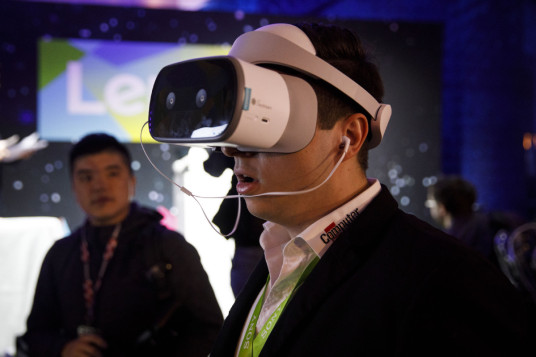Lenovo charts way ahead with smart technology
 |
|
An attendee uses the Lenovo Group Ltd Mirage Solo VR headset with Google Daydream and Mirage Camera during the 2018 Consumer Electronics Show in Las Vegas, Nevada. [Photo/Agencies] |
Chinese PC maker Lenovo will push ahead its new strategy in three areas of smart technology-smart IoT, smart infrastructure and smart verticals, the company's CEO announced at the company's annual kickoff meeting in Raleigh, North Carolina, on Tuesday.
In an interview with China Daily after the meeting, Yang Yuanqing, chairman and CEO of Lenovo Group, said the past few years have laid a solid foundation for the company to push ahead with a new strategy in the field of smart technology.
"We would like to bring smarter technology to all, from consumers to small business services, from commercial to enterprise and even telecom customers," Yang said.
He said the three areas of "smart" technology are smart internet of things (IoT), which forms the essential texture for this connected world; smart infrastructure, which provides the computing, storage and networking power to support intelligence and smart verticals which provides intelligent solutions from end to end to solve customers' real problems.
"This is definitely a new line of business, with a new business model, requiring new capabilities," Yang said.
"But we have our unique advantages-our dedication and focus over the past four years have given us probably the most complete set of building blocks for the era defined by intelligence, namely, SIOT and smart infrastructure, along with AI, big data, and services," he said.
The new strategy came out as the company has begun to see some rewards from the multibillion-dollar acquisitions of IBM's commodity server business and Google's Motorola Mobility smartphone unit.
"For two quarters in a row, Lenovo has returned as world's number one PC company. We took the crown back; we vow we will never let it slip away again," said Yang.
"And for the first time after the Motorola acquisition, the Mobile Business Group started to make a profit-globally, after we adjusted the strategy to be more focused," Yang said.
Yang said the company has passed through its most difficult period, in which it spent the past few years refocusing on smart devices, data center services as well as mobile, in what the company calls its "intelligent transformation" to capitalize on the rapid global growth of the internet of things market, as well as the wider adoption of artificial intelligence and automation.
"We were trying to tackle three challenges at the same time-integrating two big acquisitions, transforming into a customer-centric, multi-business company, and developing a new strategy," Yang said.
"It's time for a higher level of design-to optimize, combine, and assemble these building blocks," Yang added.
In 2018, Lenovo had a 22.5 percent share of the global PC market, with shipments of 58.467 million units. The figures were higher than in the previous year-20.8 percent and 54.669 units, according to data from consultancy Gartner.
"In North America, we grew almost five times faster than the market, and broke our records in market share, volume, revenue, profit… in every aspect," said Yang.
"I think one of the factors that have helped our PC business grow significantly in North America is just having the best in class products," Matthew Zielinski, president for Lenovo North America, told China Daily in an interview. "This year so far we achieved our highest market share ever as a region in the third calendar quarter of last year."
"When we are able to get our products into the hands of more users, people tend to buy them," Zielinski said. "When they're looking at us versus our major competitors, as long as they've tested and used and tried our product a little bit, they tend to buy it."
Zielinski said in the US, the company's acquisition engine is very strong. "So winning new business and new customers in the corporate space for us last year was extraordinary-our corporate business was up in significant double digits," he added.
For small and medium-sized businesses, "our business in the most recent reported quarter was up 45 percent year-on-year, which is really about enabling our channel partners to help feed our product into the masses," Zielinski said.
He said the business has also been very successful in the public sector, with year-on-year growth of 26 percent.
"It's a sign of the beginning of state and local government trust as well as a higher education trust that started last year, but will continue significantly as we go through this current fiscal year," Zielinski said.
"We're very proud of our continued momentum among US consumers," Zielinski said, adding that the company has been very successful in the US, which has led to a significant year-on-year growth.
The company in November posted a third, straight quarter of profit growth as its data center unit posted much-reduced losses of $3 million, allowing it to say it was on track to be a "sustainable, profitable growth engine."
"Our Data Center Group team doubled software-defined revenue, and more than doubled hyper-scale revenue last year," said Yang.
"We've had a year where we transformed the product line-we transformed the leadership in the organization; we transformed our partnerships; and we built major alliances like the Lenovo NetApp joint venture in China," Kirk Skaugen, president of Lenovo's Data Center Group, told China Daily.
"All of this has driven us now after two-and-a-half years to be one of the fastest growing server and storage companies in the world, and also very global with our products now in more than 160 countries," said Skaugen.
